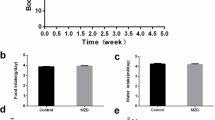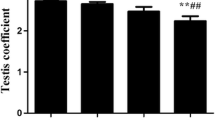Abstract
The purpose of this study was to investigate the effects of excessive zinc intake on the testes and on sperm count and motility in mice. Thirty Balb c mice were divided randomly into 3 groups of 10 animals in each. Group I acted as controls; group II was supplied with drinking water containing 1.5 g/100 mL Zn, and group III was supplied with drinking water containing 2.5 g/100 mL Zn. The animals were sacrificed after 3 wk supplementation and the epididymis and testis were quickly excised. A negative correlation between Zn dose and sperm count and motility was found. The sperm count in group III was significantly lower than in groups II and I (p<0.05). The sperm motility in group III was significantly lower than in the controls (p<0.05). Degenerative changes, including spermatic arrest, degeneration of seminiferous tubules, and fibrosis in interstitial tissue, were observed in group III animals. These results show that high doses of zinc significantly alter sperm motility.
Similar content being viewed by others
References
P. J. Aggett and J. T. Harries, Current status of zinc in health and disease states, Arch. Dis. Child. 54, 909–917 (1979).
R. S. Bedwal and A. Bahuguna, Zinc, copper and selenium in reproduction, Experimentia 50, 626–640 (1994).
D. I. Lewis-Jones, I. A. Aird, M. M. Biljan, et al., Effects of sperm activity on zinc and fructose concentrations in seminal plasma, Hum. Reprod. 11, 2465–2467 (1996).
I. R. Hurley, A. Hershlag, and S. Benoff, Mannose receptors, zinc and fertilization success, Arch. Sex. Transm. Dis. 11, 241–253 (1997).
H. Fuse, T. Kazama, S. Ohta, et al., Relationship between zinc concentrations in seminal plasma and various sperm parameters, Int. Urol. Nephrol. 31, 401–408 (1999).
N. Batra, B. Nehru, and M. P. Bansal, The effect of zinc supplementation on the effects of lead on the rat testis, Reprod. Toxicol. 12, 535–540 (1998).
H. H. Luk, J. K. S. Ko, H. S. Fung, et al., Delineation of the protective action of zinc sulfate on ulcerative colitis in rats, Eur. J. Pharmacol. 443, 197–204 (2002).
G. Abban, G. Turgut, D. Erdogan, et al., Transmission electron microscopy study of the effects of zinc overdose on mouse liver tissue, Biol. Trace Element Res., 95, 87–94 (2003).
S. Chia, C. Ong, L. Chua, et al., Comparison of zinc concentrations in blood and seminal plasma and the various sperm parameters between fertile and infertile men, J. Androl. 21, 53–57 (2000).
H. Stankovic and D. Mikac-Devic, Zinc and copper in human semen, Clin. Chim. Acta. 70, 123–126 (1976).
W. Y. Wong, G. Flik, P. M. W. Groenen, et al., The impact of calcium, magnesium, zinc, and copper in blood and seminal plasm on semen parameters in men, Reprod. Toxicol. 15, 131–136 (2001).
G. Noack-Füller, C. deBeer, and H. Seibert, Cadmium, lead, selenium, and zinc in semen of occupationally unexposed men, Andrologia 25, 7–12 (1993).
R. Henkel, J. Bitter, R. Weber, et al., Relevance of zinc in human sperm flagella and its relation to motility, Fertil. Steril. 71, 1138–1143 (1999).
S. Andò, A. Carpino, M. Buffone, et al., Fructose, prosatic acid, phosphatase and zinc levels in seminal plasma of varicoceles, Int. J. Fertil. 35, 249–252 (1990).
U. Kvist, Importance of spermatozoal zinc as temporary inhibitor of sperm nuclear chromatin decondensation ability in man, Acta Physiol. Scand. 109, 79–84 (1980).
G. Danscher, R. Hammen, E. Fjerdingstad, et al., Zinc content of human ejaculate and the motility of sperm cells, Int. J. Androl. 1, 576–581 (1978).
A. Carpino, L. Siciliano, M. F. Petrone, et al., Low seminal zinc bound to high molecular weight proteins in asthenozoospermic patients, Hum. Reprod. 13, 111–114 (1998).
Author information
Authors and Affiliations
Rights and permissions
About this article
Cite this article
Turgut, G., Abban, G., Turgut, S. et al. Effect of overdose zinc on mouse testis and its relation with sperm count and motility. Biol Trace Elem Res 96, 271–279 (2003). https://doi.org/10.1385/BTER:96:1-3:271
Received:
Revised:
Accepted:
Issue Date:
DOI: https://doi.org/10.1385/BTER:96:1-3:271




